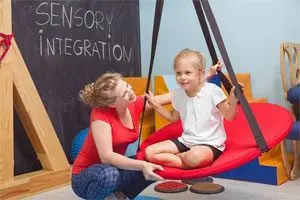Contents
Sensory processing disorder is called sensory integration dysfunction. Many parents are not even aware that their child has this problem. They consider deviations in behavior as ordinary whims. In fact, this is a real diagnosis, which very often remains hidden. An example of a violation of sensory integration is intolerance to loud noise or strong smells, refusal to wear “prickly” things, etc. It is possible to cope with the problem, but the approach must be correct.
The importance of sensory integration for the proper development of the child

The nervous system can be compared to an electrical circuit. In order for it to function correctly, high-quality work of all its sections is necessary. If some link does not withstand the voltage, or has increased resistance, a “short circuit” may occur. This simple example helps to understand how the nervous system works.
The brain every second receives signals from the external environment and from internal organs. Moreover, he begins to work even when the child is in the womb. After the birth of the baby, his activity intensifies.
If the child is healthy, then he begins to learn the world through sensory perception. His hands help him with this. He feels objects, tries to “taste the world”. In such a situation, problems with the development of motor skills and speech do not arise.
If the brain or its branches have been damaged, for example, due to oxygen starvation of the fetus, then the processing of sensory information will be impaired. A similar situation is observed when a child is brought up in poor conditions, when he is deprived of the opportunity to satisfy his basic psychophysiological and social needs.
Proper sensory integration is important for health, for the formation of mental abilities, mastery of communication skills, household skills.
Diagnosis of sensory integration disorders

Even one single violation can cause serious problems. It is enough to imagine how difficult it is for a child to concentrate on what the teacher says when birds chirp merrily outside the window and the T-shirt irritates the skin. Or maybe he wants to hide from the bright lights in the classroom or plug his ears so as not to hear the hum of voices. An adult can control his actions. The behavior of the child in this regard is different. It gives a reaction of the “here and now” type.
On the other hand, not every refusal to wear a sweater or fish soup should be considered a violation of sensory integration. Diagnosis should be carried out by a specialist. Minor deviations may resolve on their own with age. There is evidence that every sixth child has “whims” as a result of violations in the work of sensory systems. Sometimes this greatly interferes with development.
The following markers help identify the problem:
Violations in the integration of auditory information: fear of loud sound, intolerance to music, confusion when entering a noisy place. Children with such problems may cover their ears with their hands when the noise increases, will remain in the classroom during recess, etc.
Violations of the integration of visual information: love for twilight or darkness, increased anxiety in bright light, tension when trying to examine the objects and objects surrounding the child. The kid will express clear negativism when it is necessary to overcome obstacles.
Disorders of tactile perception: the child does not like to sculpt and draw, he does not like being touched. Children refuse to wear certain fabrics or certain styles, such as turtlenecks. They do not go barefoot, but at the same time they react poorly to pain and temperature stimuli.
Disturbances in the work of the vestibular system: the child is clumsy, awkward, does not like active games, cannot learn to ride a bicycle or skate, often falls, all the time looking for support.
The main symptom of sensory integration disorder is difficulty concentrating. It will be especially difficult for a child in situations where stimuli come from outside that affect the problem area. Such children often change the type of activity, they are restless, anxious, their behavior is affective. They are prone to tantrums, whims, aggression, bursting laughter, which can turn into sobs, etc.
Therapy for Sensory Integration Disorders

It has been proven that children with autism in 90% of cases suffer from violations in the sensory sphere. Therefore, they react in a peculiar way to external stimuli. At the same time, not all patients with sensory integration dysfunction are autistic. Sometimes these violations are expressed so strongly that experts make an incorrect diagnosis. Therefore, the diagnosis must be thorough. Only then can treatment begin. A well-designed therapeutic regimen will improve the child’s condition, including with some other diagnoses.
Correction of sensory integration is required for children with scoliosis, phobias, panic attacks, impaired speech development, motor coordination, and writing difficulties.
Other indications include:
Muscular contractures.
Hyperactivity.
ZPR
Cerebral palsy.
Postponed operations, injuries and fractures. Treatment is carried out during the recovery period.
Down syndrome.
Autism etc.
For each patient, exercises are selected that will help him to better perceive information. Such exercises are called sequences. They are played in the form of a game. Rocking chairs and dry pools familiar to every child help in the exercise. For example, the kid is offered to find some objects in the pool or shift a toy from one box to another, while swinging in a hammock.
The result of the therapy will be the harmonious development of the baby. It will be faster and easier to cope with the existing difficulties in the perception of the world around.









